
Growing up, most of us have heard our fair share of fairy tales about knights in shining armor, princesses locked up in towers and wise caterpillars who smoked pipes and gave words of advice to young girls lost in Wonderland. Somehow, these fairy tales have played a huge role in shaping our childhood and fueling our imagination and creativity. In case of avid readers such as myself, these fairytales had turned me into a bookworm and inspired me to maybe write my own story about magic and myth someday.

What I find really interesting is how these stories seem to have a life of their own, and have been told from one generation to another for who knows how many thousands of years. There is no denying the love we have about tales of a malicious queen obsessed with being the fairest in all lands—in fact we are so fascinated by these characters and the so many facets of human nature they represent (think about the little mermaid’s selflessness when she chose to take her own life rather than kill the prince so she could return home to her family), that writers today have taken to adding a bit of their own imagination to these beloved stories, twisting them and changing them until they mean something new.
The biggest example of such a retelling must be The Lunar Chronicles by Marissa Meyer. It’s not merely because The Lunar Chronicles follows the tales of Cinderella, Red Riding Hood, Rapunzel and Snow White but rather because of how Meyer changed this familiar fairy tales to tell new fairytales—fairytales that (as the back cover of Cinder proudly claims) you will never forget.
Whereas Cinderella was always portrayed as a damsel in distress in every version of her story, rescued only by a magical fairy godmother (and in some versions by violently killing her stepmother and step sisters), the Cinderella, or Cinder, the protagonist of the first book of the same name in The Lunar Chronicles, is a young gifted cyborg mechanic who leaves aside dreams of balls, romance and dancing with a handsome prince so that she can escape the cruelty of her stepmother and guardian. Unlike the character she was based on, Cinder recognizes the ill-treatment she is forced to suffer and instead of accepting it she tries to fight back and earn her freedom however she could. It was one of the things I truly loved about her—aside from her wit and sarcasm—because the original Cinderella always seemed too submissive to me, whereas Cinder was more practical, down-to-earth and self-dependent.

Another fairytale where the main character is a strong, relatable protagonist would be Sarah J. Maas’s Feyre of A Court of Thorns And Roses, aka Belle from Beauty and The Beast. Though I have yet to read this book, the hype this book elicited from the bookish community and having read one of S. J. Maas’s books myself I have no doubt that ACOTAR is another wonderful example of how traditional fairy tales can be changed to mean something new, something that today’s readers would be able to relate to more.
Not all retellings stray so far from their origins though. Daughter of The Forest by Juliet Marillier stays true to Han’s Christen Anderson’s The Wild Swans in terms of the plot, the characters and even the submissive nature of the main character, just with more emotional resonance and a depiction of a heart-wrenching but real world issue that has existed in our society since the dawn of time. While the original story was beautiful with its themes of tragedy, magic and brotherly love, the retelling is just as enchanting.
Similarly, A Thousand Nights by E. K. Johnston also stays true to the original One Thousand and One Nights story through the similarities between the unnamed main character of the retelling and Scheherazade, a wise, witty and incredibly intelligent legendary queen who turns a cruel, heartless misogynist king into a kind, just ruler by simply telling him fascinating, moral stories for 1001 nights.
The reason why I bring up these differences and similarities between today’s retellings of children’s tales and the original tales is to highlight the impact each has on the reader’s mind. While I cannot recommend The Lunar Chronicles to a mere five-year old, I do believe that the message of being self-dependant that Cinder sends to the readers is much more valuable than the message Cinderella sends to young readers: look pretty, don’t say anything when someone mistreat you and wait for fairy godmother to come to your rescue.

I think it would be great if today’s writers could make a retelling of these stories that are targeted for much younger readers–if it was possible to translate the same motivating message that the YA retellings have into stories that are suited for a younger audience, that would be great. When I look at my six-year old cousin reading about how Sleeping Beauty was rescued by true love’s kiss, I think “hey that’s not so bad but wouldn’t it be better if she read about a Sleeping Beauty who defeated Maleficent herself in order to save her family and her kingdom?” There’s nothing wrong with boys doing all the slaying and saving, but in a world where it is still difficult for women to fight wars alongside men due to unequal rights and harassment, wouldn’t it be much better for the future generation if we made them accustomed to the idea of girls being just as capable as boys from a very young age? It’s not like fairy tales that focus on women empowerment does not exist (think Mulan and Pocahontas) but I cannot help but feel that instead of telling our children about these iconic female figures, we are focusing on too much on the damsels in distress. Instead of teaching them about how outer beauty pales to inner beauty we are teaching them that Snow White’s prince fell in love with her because he had never seen anyone as beautiful as her.

So from now on, let’s be more careful about what we are teaching our little brothers and sisters. Let’s add a little twist to the fairy tales that we grew up with so that the little ones can be inspired by girls in shining armor. Let’s motivate them, the way the YA retellings of our childhood fairy tale have motivated us.
1 thought on “Once Upon A Time In Retellings”